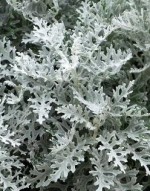 Dusty miller is a half-hardy perennial native to the Mediterranean area and a member of the aster family, Asteraceae, that also includes daisy, yarrow, and lettuce. It grows 12-24″ tall and has silver-gray woolly leaves up to 6″ long that are lobed or deeply incised so as to give a lacy appearance that sets off the appearance of other plants to advantage. In summer, small mustard yellow daisy-like flowerheads appear beginning in the second year. Considered a subshrub, dusty miller is usually grown as an annual in cool areas but often returns in USDA Zone 7 and warmer. Dusty miller likes warm temperatures and a dry climate but it also does very well in the heat and humidity. It is a good container plant but is most often seen as a edging plant and has been over used at times. The foliage as useful in a vase arrangement as it is in the garden and at Christmas time looks beautiful combined fresh or dried with red roses. The genus name, Senecio, comes from the Latin word senes meaning old man and refers to the hoary pappus of the plant. The specific epithet, cineraria, is from the Latin word cinerarius meaning pertaining to ashes and refers to the ash-colored down on the leaves.
Dusty miller is a half-hardy perennial native to the Mediterranean area and a member of the aster family, Asteraceae, that also includes daisy, yarrow, and lettuce. It grows 12-24″ tall and has silver-gray woolly leaves up to 6″ long that are lobed or deeply incised so as to give a lacy appearance that sets off the appearance of other plants to advantage. In summer, small mustard yellow daisy-like flowerheads appear beginning in the second year. Considered a subshrub, dusty miller is usually grown as an annual in cool areas but often returns in USDA Zone 7 and warmer. Dusty miller likes warm temperatures and a dry climate but it also does very well in the heat and humidity. It is a good container plant but is most often seen as a edging plant and has been over used at times. The foliage as useful in a vase arrangement as it is in the garden and at Christmas time looks beautiful combined fresh or dried with red roses. The genus name, Senecio, comes from the Latin word senes meaning old man and refers to the hoary pappus of the plant. The specific epithet, cineraria, is from the Latin word cinerarius meaning pertaining to ashes and refers to the ash-colored down on the leaves.
Type: Half-hardy perennial usually grown as annual
Bloom: Mustard yellow flowers are borne in clusters in summer.
Foliage: Lobed or deep incised silver-gray leaves.
Size: 1-2� H x 1� W
Light: Full sun to partial shade (leaves become greenish in too much shade)
Soil: Medium to low fertility,� sandy, well-drained; fairly drought tolerant once established
Hardiness: Zones 8-10, 7 with protection; usually grown as annual
Care: Low maintenance
Pests and Diseases: None of significance
Propagation: Seed or terminal cuttings
Companion plants: Plants with intensely colored flowers such as portulaca, red or purple salvia, marigolds, pansies, magenta or red roses.
Outstanding Selections:
�Cirrus� (8-10� tall)
�Silver Dust� (deeply incised, 15� tall)